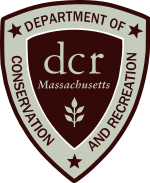Department of Conservation and Recreation

Massachusetts Dept. of Conservation and Recreation seal
|
|

Agency logo
|
|
| Department overview | |
|---|---|
| Headquarters | 251 Causeway Street, Boston |
| Department executive |
|
| Website | [3] |
The Department of Conservation and Recreation (DCR) is a state agency of the Commonwealth of Massachusetts, situated in the Executive Office of Energy and Environmental Affairs. It is best known for its parks and parkways. As of December 9, 2015[update], the Commissioner of the DCR is Leo Roy. The DCR's mission is "To protect, promote and enhance our common wealth of natural, cultural and recreational resources for the well-being of all." The agency is the largest landowner in Massachusetts.
The Department of Conservation and Recreation was formed in 2003 under Governor Mitt Romney, when the former the Metropolitan District Commission (MDC) and the Department of Environmental Management (DEM) were merged to form the DCR.
Ownership and management for many nonpedestrian bridges was transferred to the Massachusetts Department of Transportation in 2009.
The DCR is under the general management of the Commissioner of the DCR. The general administration divisions; Human Resources Division, the Financial Division, and External and Legislative Affairs, report directly to the Commissioner. It has two divisions
and several bureaus, offices, and other work units, including (but not exclusively)
The Division of State Parks is responsible for the maintenance and management of over 310,000 acres (1,250 km2) of state-owned forests and parks. These areas are designated as either Woodlands, Parklands, or Reserves, and are managed to maintain specific land-use characteristics.
From the agency's beginning in 2003 until 2012, DCR land management was organized into three divisions: State Parks and Recreation, Urban Parks and Recreation, and Water Supply Protection. In 2012, State Parks and Urban Parks were unified into one division.
Within the greater Boston area there are urban wilds, historic sites, and other naturally aesthetic or significant environmental properties. The origins of the collective environments in this part of the division date back to the creation of the Metropolitan Park Commission in 1893, forming the first such regional system in the United States. (see Metropolitan Park System of Greater Boston for history).
...
Wikipedia
